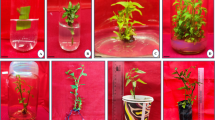Summary
Somatic proembryos of mango (Mangifera indica L. cv. Hindi) were co-cultivated withAgrobacterium tumefaciens strain A208 harboring pTiT37-Se::pMON 9749 (9749 ASE). Transformed somatic proembryos capable of growing on selection medium containing 200 μg/ml kanamycin produced the characteristic indigo blue precipitate in the presence of 5-bromo-4-chloro-3-glucuronic acid. These proembryos were chimeral consisting of transformed (blue) and nontransformed (yellow/white) cells. A stepwise selection strategy was found necessary to eliminate chimeras. a) Initial screening at 200 μg/ml kanamycin to enable growth of transformed cells, b) further screening at 400 μg/ml kanamycin to reduce chimeras, and c) recovery of pure transformed clones of proembryos in liquid selection medium with 100 μg/ml kanamycin. The integration of the NPT II and GUS genes into mango genome was confirmed by Southern hybridization.
Similar content being viewed by others
References
De Block, M. Factors influencing the tissue culture and theAgrobacterium tumefaciens-mediated transformation of hybrid aspen and poplar clones. Plant Physiol. 93:1110–1116; 1990.
Dewald, S. G.; Litz, R. E.; Moore, G. A. Optimizing somatic embryo production in mango. J. Am. Soc. Hortic. Sci. 114:712–716; 1989a.
Dewald, S. G.; Litz, R. E.; Moore, G. A. Maturation and germination of mango somatic embryos. J. Am. Soc. Hortic. Sci. 114:837–841; 1989b.
Feldman, K. A.; Marks, M. D.Agrobacterium mediated transformation of germinating seeds ofArabidopsis thaliana: a nontissue culture approach. Mol. & Gen. Genet. 208:1–9; 1987.
Fillatti, J. J.; Sellmer, J.; McCown, B., et al.Agrobacterium-mediated transformation and regeneration ofPopulus. Mol. & Gen. Genet. 206:192–199; 1987.
Fitch, M. M.; Manshardt, R. M.; Gonsalves, D., et al. Stable transformation of papaya via microprojectile bombardment. Plant Cell Rep. 9:189–194; 1990.
Food and Agricultural Organization. Production Yearbook 41. Rome: Food and Agricultural Organization of the United Nations; 1987.
Fraley, R. T.; Rogers, S. G.; Horsch, R. B., et al. The SEV system: a new disarmed Ti plasmid vector system for plant transformation. Bio/Technology 3:629–635; 1985.
Gamborg, O. L.; Miller, R. A.; Ojima, K. Plant cell cultures. I. Nutrient requirements of suspension cultures of soybean root cells. Exp. Cell. Res. 50:150–158; 1968.
Graham, J.; McNicol, R. J.; Kumar, A. Use of the GUS gene as a selectable marker forAgrobacterium-mediated transformation ofRubus. Plant Cell Tissue Organ Cult. 20:35–39; 1990.
Hammerschlag, F. A.; Owens, L. D.; Smigoki, A. C.Agrobacterium-mediated transformation of peach cells derived from mature plants that were propagated in vitro. J. Am. Soc. Hortic. Sci. 114:508–510; 1989.
Hidaka, T.; Omura, M.; Ugaki, M., et al.Agrobacterium-mediated transformation and regeneration ofCitrus spp. from suspension cells. Jpn J. Breed. 40:199–207; 1990.
James, D. J.; Passey, A. J.; Barbara, D. J., et al. Genetic transformation of apple (Malus pumila Mill) using a disarmed T-binary vector. Plant Cell Rep. 7:658–661; 1989.
Jefferson, R. A. Assaying chimeric genes in plants: the GUS gene fusion systems. Plant Mol. Biol. 5:387–405; 1987.
Litz, R. E. In vitro somatic embryogenesis from nucellar callus of monoembryonic mango. HortScience 19:715–717; 1984.
Litz, R. E.; Knight, R. K.; Gazit, S. Somatic embryos from cultured ovules ofMangifera indica L. Plant Cell Rep. 1:264–266; 1982.
Litz, R. E.; Mathews, H.; Bharathan, N., et al. Transformation of somatic embryos of mango. Seventh International Congress on Plant Tissue and Cell Culture. Amsterdam. Abstract 67; 1990.
Maniatis, T.; Fritsch, E. F.; Sambrook, J. Molecular cloning: a laboratory manual. Cold Spring Harbor, NY: Cold Spring Harbor Press: 1987.
Mathews, H.; Bharathan, N.; Litz, R. E., et al. Transgenic plants of mustardBrassica juncea (L.) Czern and Coss. Plant Sci. 72:245–252; 1990.
Mathews, H.; Litz, R. E. Kanamycin sensitivity of mango somatic embryos. HortScience 25:965–966; 1990.
Mathews, H.; Litz, R. E. Mango. In: Hammerschlag, F. A.; Litz, R. E., eds. Biotechnology of perennial fruit crop species. Wallingford: CAB International; 1992: 433–448.
McCabe, D. E.; Sain, W. F.; Martinell, B. J., et al. Stable transformation of soybean (Glycine max) by particle acceleration. Bio/Technology 6:923–926; 1988.
McCown, B. H.; McCabe, D. E.; Russell, D. R., et al. Stable transformation ofPopulus and incorporation of pest resistance by electrical discharge particle acceleration. Plant Cell Rep. 9:590–594; 1991.
McGranahan, G. H.; Leslie, C. A.; Uratsu, S. L., et al. Improved efficiency of the walnut somatic embryo gene transfer system. Plant Cell Rep. 8:512–516; 1990.
McGranahan, G. H.; Leslie, C. A.; Uratsu, S. L., et al.Agrobacterium mediated transformation of walnut somatic embryos and regeneration of transgenic plants. Bio/Technology 6:800–804; 1988.
Miller, J. H. Experiments in molecular genetics, Cold Spring Harbor, NY: Cold Spring Harbor Laboratory Press; 1972:466.
Moore, L. W.; Anderson, A.; Kado, C. I. Gram negative bacteria. In: Schadd, N. W., ed. Laboratory guide for identification of plant pathogenic bacteria. St. Paul, MN: Bacteriology Committee of American Phytopathological Society; 1980.
Mullins, M. G.; Tang, F. C. A.; Facciotti, D.Agrobacterium-mediated genetic transformation of grapevines: transgenic plants ofVitis rupestris scheele and buds ofVitis vinifera L. Bio/Technology 8:1041–1045; 1990.
Murashige, T.; Skoog, F. A revised medium for rapid growth and bioassays with tobacco tissue cultures. Physiol. Plant. 15:473–497; 1962.
Pang, S. Z.; Sanford, J. C.Agrobacterium-mediated gene transfer in papaya. J. am. Soc. Hortic. Sci. 113:287–291; 1988.
Rogers, S. O.; Bendich, A. J. Extraction of DNA from milligram amounts of fresh, herbarium and mummified plant tissues. Plant Mol. Biol. 5:69–76; 1985.
Wilde, H. D.; Meagher, R. B.; Merkle, S. A. Expression of foreign genes in transgenic yellow-poplar. Plant Physiol. 98:114–120; 1992.
Author information
Authors and Affiliations
Rights and permissions
About this article
Cite this article
Mathews, H., Litz, R.E., Wilde, H.D. et al. Stable integration and expression of β-glucuronidase and NPT II genes in mango somatic embryos. In Vitro Cell.Dev.Biol.–Plant 28, 172–178 (1992). https://doi.org/10.1007/BF02823312
Received:
Accepted:
Issue Date:
DOI: https://doi.org/10.1007/BF02823312




